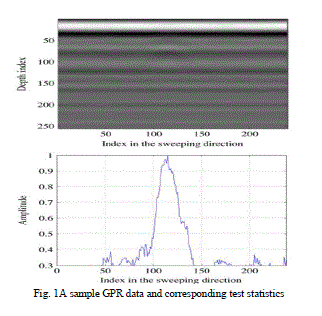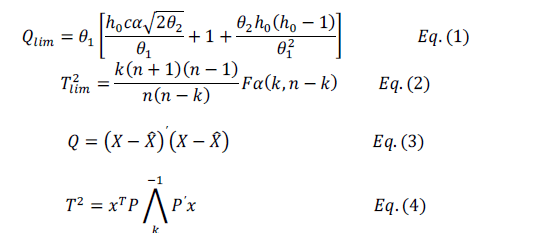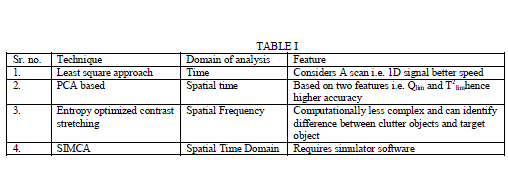ISSN ONLINE(2319-8753)PRINT(2347-6710)
ISSN ONLINE(2319-8753)PRINT(2347-6710)
| P. P. Sadgir, V. R. Ratnaparkhe, A. S. Bhalchandra Department of Electronics and Telecommunication Engineering, Government College of Engineering, Aurangabad (M.S.), India. |
| Related article at Pubmed, Scholar Google |
Visit for more related articles at International Journal of Innovative Research in Science, Engineering and Technology
The subsurface targets i.e. low metallic content mines or non-metallic landmines are one of the difficult subsurface targets to be detected using geophysical techniques. Ground penetrating radar (GPR) is one of the techniques used for the detection of these targets which has become popular due to its advantages like high resolution, non-contact sensing and being sensitive to changes in all types of electrical characteristics.As there is risk of loss of life the technology should support detection without digging in this application as well as the technique should be real time. The paper reviews the real time techniques for the landmine detection.
Keywords |
| GPR, landmine, least square approach, PCA, entropy optimized contract stretching, SIMCA |
INTRODUCTION |
| In many applications detection of buried objects is important like in archaeological investigations, forensic investigations and security applications. In the applications such as buried landmine or other explosive detected efficient and safe removal of these objects becomes very important. As there is risk of loss of life the technology should support detection without digging. There are many techniques for detection of buried object like nucleonic, radiometric, thermo graphic and GPR. Among all these GPR is mostly used for this application. GPR is non-contact sensor which is convenient for handheld devices and also high resolution which makes it more popular for this application.GPR has few advantages over other subsurface sensing technology like sensitivity to changes in all three types of electromagnetic characteristics of a medium i.e. electric permittivity, electric conductivity and magnetic permeability, and unlike other sensors GPR can survey an area ahead. Hence GPR system can be used to detect dangerous objects before the systems moves over and past them. This paper reviews the various methods for real time landmine detection using GPR. |
II. LEAST SQUARES APPROACH |
| Evaluation of differences between consecutive GPR signals taken at adjacent points is required for detecting a buried landmine. Each 1D GPR signal taken at a specific point is called an A scan. Hence, a detection algorithm should distinguish between A scans taken in presence and absence of a buried object. This can be viewed as an estimation problem. An A scan should be estimated from earlier A scans taken in the absence of landmine. After measuring the signal at the point for which the signal was predicted we can determine whether mine is present or not by observing the difference. If the value of difference is higher presence of the buried object can if concluded or else not. AhmetBurakYoldemir[1] has proposed the least squares approach for prediction and comparison of A scans. In this technique proposed from the A scans having no buried object the next A scan is to be estimated by using least square algorithm. Then actual GPR signal at that point is to be measured and if observed signal and the estimated signal are similar then there is no buried object present. But if the large difference exists between the desired and observed then mine is present. The difference is calculated based on the Euclidian norm. In this method first 10 scans are used to calculate the filter coefficients required for the prediction. Later the filter coefficients calculated are kept fixed and then using those filter coefficients the next values are calculated. Figure 1 shows A sample GPR data and corresponding test statistics Authors report that proposed method gives 100% performance at a FAR of 10%, when 10 A scans are used to estimate the next A- scan. |
 |
III. PCA BASED APPROACH |
| For reducing the dimensionality in data analysis PCA, i.e. principal component analysis, is a popular technique. It has three major advantages. First, the PCA parameters can be calculated directly from the data. Second, in terms of mean squared error, it is the optimal linear method for dimensionality reduction. Third, once the PCA parameters are calculated, construction and reconstruction become computationally easy operations.GülayBüyükaksoy Kaplan [2] proposes the algorithm using PCA for real time detection of the landmine.The values of GPR radargram are needed to normalise to zero mean and unit variance before using PCA. At first the Safe region window is constructed then window data is normalised then the principal components of the window data are analysed and Qlim(Eq.1) and T2 lim(Eq.2)is calculated for that safe region. When new sample is obtained then firstly normalise it then calculate the Qnew(Eq.3)and T2 new(Eq.4)statistics for the new sample. Then check if Qnew>QlimandT2 new > T2 liminclude new sample in the window if condition is not satisfied. If the condition is satisfied then generate the detection alarm. Slide the window and repeat the procedure. In this way the real time landmine detection can be done. The principal components are decided based on cumulative percent variance (CPV) given by (Eq.5). |
 |
 |
IV. ENTROPY OPTIMIZED CONTRAST STRETCHING |
| M.P. Priyadarshini [3] proposes in the paper the method based on entropy optimized contrast stretching for the landmine detection. In this technique the steps followed were pre-processing, image cropping and spectral analysis. At the pre-processing step the windowed averaging is done for removing air to ground interface effect followed by the contrast stretching step whose thresholds are decided by using the entropy optimization. After the contrast stretching step the hyperbolas obtained in this image are cropped and spectral analysis of those is done. If in the energy density spectrum more than one sharp peak then the hyperbola is non-mine hyperbola if the energy spectrum density has only one sharp peak then it is considered as mine signature. All these steps are followed for each B-scan if the mine signature is found then the system gives an alarm. |
V. SIMCA ALGORITHM |
| The SIMCA algorithm i.e. simulated correlation algorithm is a method proposed by AnandSengodam [4] [5] in which a correlation is carried out between simulated GPR trace. Here the GprMAX2Dv1.5 software was used to simulate the ideal trace to a point reflector was placed in same soil conditions as experimental setup. The original GPR after pre- processing and removing clutter are correlated and convolved with the simulated GPR results to determine the mine location. This mine location is validated using human users. The locations predicted by authors were said to be accurate to acceptable degree. |
VI. COMPARISON TABLE |
 |
VII. CONCLUSION |
| All the techniques considered in this paper have a real time approach to the problem of landmine detection. The least squares approach considers the A- scan and hence the technique handles the signals than the image which provides better speed. The PCA based approach is based on two features which provide better accuracy and lower false alarm rate. The entropy optimized contrast stretching technique is computationally simple and considers the frequency domain features of the data. For SIMCA technique acceptable level of accuracy can be achieved but simulator is required.Hence least square approach technique is best suited for the application as it can givereal time results at higher speed in all types of soils. |
References |
|